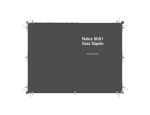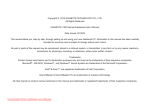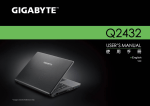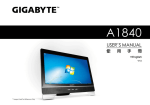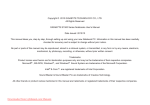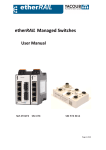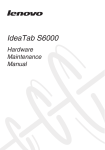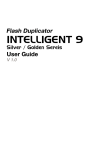Download Content - Gigabyte
Transcript
Copyright © 2011 GIGABYTE TECHNOLOGY CO., LTD. All Rights Reserved GIGABYTE Q1700 Series Notebooks User’s Manual Date Issued: 2011/07 This manual takes you, step by step, through setting up and using your new Notebook PC. Information in this manual has been carefully checked for accuracy and is subject to change without prior notice. No part or parts of this manual may be reproduced, stored in a retrieval system, or transmitted, in any form or by any means, electronic, mechanical, by photocopy, recording, or otherwise, without prior written consent. Trademarks Product names used herein are for identication purposes only and may be the trademarks of their respective companies. GIGABYTETM is the trademark of GIGA-BYTE TECHNOLOGY CO., LTD. Microsoft® , MS-DOS, Windows® , and Windows® Sound System are trademarks of the Microsoft Corporation. AMD®, and Radeon TM are registered trademarks of Advanced Micro Devices, Inc. All other brands or product names mentioned in this manual are trademarks or registered trademarks of their respective companies. English I General Safety Precautions In order to ensure your safety and the safety of you notebook, we ask that your carefully follow these safety precautions. CAUTION: Using your notebook for long periods of time, with the base resting directly on exposed skin, can cause injury, burns or discomfort from the heat buildup that is generated from the base of your portable computer. ● After removing the notebook from the box, please ensure that all packaging materials are kept out of the reach of small children as they can cause a potential choking hazard. The packaging materials should be safely stored away in the event that it may be used again for safe transportation of the notebook. ● Ensure that the AC Adapter and power cable are placed in a safe area where it cannot be tripped over or stepped on. The AC Adapter should be situated in a well ventilated area and should have nothing resting on or covering it. ● Before turning on the notebook, ensure that it is placed on a level surface with at least 10 cm of clearance around the air vents, which will aid in proper cooling. ● Do not obstruct the air vents of the notebook and do not insert any foreign objects into this space. Doing this may cause a short circuit or may cause the CPU fan to malfunction, resulting in the risk of a fire or electric shock. This may eventually render permanent damage to the notebook. ● Do not press or touch the display panel. ● Only use the AC Adapter that is provided with the notebook or that which is recommended by the manufacturer. Using nonrecommended or non-approved parts may cause damage or increase the risk of a fire or explosion. In the event that another AC Adapter is ● ● ● ● ● ● ● required, advice should be sought from a GIGABYTE service agent, in order to make sure that the correct part is recommended. Please follow the battery installation guidelines. Incorrect installation of batteries may increase the risk of a fire or explosion. Only replace old batteries with the same or an alternative compatible battery that is recommended by GIGABYTE or an authorized GIGABYTE Service Centre. Before connecting the notebook to the power outlet, make sure that the voltage rating of the AC Adapter is compatible with the power specification in the country where you are located. When using an extension cord, please make sure that the total sum of ampere ratings for all connected devices does not exceed the total ampere capacity for the circuit. Before removing the battery from the notebook, make sure firstly that the notebook is switched off and secondly that the AC Adapter is disconnected from the electrical wall socket. Once this is done, it would be safe to remove the battery. Do not carry the notebook battery, loose, in your handbag, backpack or pocket where loose metal objects (money, keys, chains, pens, etc) may be present. The metal objects can short circuit the terminals of the battery resulting in overheating that could cause a fire hazard. In the event that you need to transport the battery separately from the notebook, please place it inside an anti-static bag. Discard old worn out batteries according to the instructions on Page VII. Never throw batteries into a fire as this can cause an explosion. Never attempt to repair or service the notebook yourself. Please refer all repairs and servicing to qualified service personnel at a GIGABYTE Authorized Service Centre. Q1700 SERIES USER’S MANUAL Although notebooks are designed to be as robust as possible to cater for a mobile lifestyle, extreme care and caution should be taken when travelling. When travelling by land, sea or air, every precaution should be taken to make sure that the notebook is well secured when it is not in use. ● The most essential accessory you should have when travelling is a good carry case for your notebook. The case should be well padded to protect your notebook from drops and bumps, etc and should be big enough to hold the size of notebook. ● Make sure there is enough room to carry your AC Adapter and spare battery etc. Only carry the necessary items in your carry case, as the weight can become tedious especially when walking long distances or waiting in long queue’s. ● When travelling by air, never book your notebook in with checked baggage. Always declare it as hand baggage so that you can carry it into the airplane cabin with you. Most airlines allow two pieces of hand baggage with one of them being a bag or carry case with a portable notebook. Please consult your local airline for more details. ● When placing your notebook on an X-Ray, make sure that you keep a close eye on it when it is one the conveyor belt. Hold on to your notebook until the last minute before placing it on the conveyor. In some airports it could be stolen while you are stuck in a queue waiting to pass through the metal detector. ● Notebooks and hard drives can pass through X-Ray machines but never allow these to pass through a metal detector. This can cause data loss to the hard drive. ● Never place your notebook in the overhead storage compartment as this can make it susceptible to damage caused by turbulence that may be experienced during the flight or in other case theft. You can store your notebook under your seat, where it is always in sight. ● You should take every precaution to protect your notebook from dust, dirt, liquid spillage, food droppings, extreme weather conditions and direct exposure to sunlight. ● When travelling between different climates, from one extreme to another, condensation may occur inside the notebook. If this does happen, please allow sufficient time for the moisture to evaporate completely, before attempting to switch on. ● When travelling from extremely colder to extremely warmer climates in a short space of time, and vice versa, please allow the notebook some time to adapt to the change in environment. Usage Tips ● When unplugging the power connector from the notebook, please hold and pull on the connector or the strain relief loop to disconnect. Do not pull the power cord itself as this can cause damage to the cable or the notebook. ● In the event of an electrical storm, please disconnect the notebook from the power source and unplug any network or telephone cables that may be connected to the notebook. ● Do not use the notebook near water sources, like bathtubs, washing basins, kitchen or laundry sinks or swimming pools. Liquid that can spill onto the notebook by accident can cause electric shock to you and damage to the notebook. English Travel Tips II English III Cleaning Tips When cleaning the notebook, please make sure that the notebook is switched off and disconnected from the power source and that the battery is removed. Notebook Cover: Use a microfiber or lint free soft cotton cloth and kitchen detergent (mix 5 parts water to 1 part detergent). ● Wet the cloth and wring out all excess liquid and wipe the surfaces clean. ● Take extra care to make sure that the cloth is damp and not very wet, especially when cleaning around the air vents and other openings as too much liquid in the cloth could drip onto the external components causing damage to the notebook. ● Do not clean the keyboard with this liquid. Keyboard: ● It is advisable to use a can of compressed air to clean debris that maybe caught underneath the keys. ● Isopropyl alcohol can be used to clean the keys by dipping a lint-free soft cloth into it, wringing out the excess liquid and wiping the keys. ● Allow to dry for at least 5 minutes. LCD: ● It is best to use a microfiber cloth to clean the surface of the LCD. ● If there are any marks or stains present, it would be wise to use commercially available LCD cleaning kit. When using a commercially available LCD cleaning kit, never spray the liquid directly onto the screen. You must spray it onto the cleaning cloth and then wipe the screen clean. ● If this is not available then you can mix 50% isopropyl alcohol and 50% distilled water to clean the surface of the LCD screen. ● Dip the lint free soft cotton cloth into the solution, wringing out excess liquid. ● The cloth must be damp but not dripping with liquid. ● Take care not to let any excess liquid drip into the notebook. ● Start from the top of the LCD surface and wipe from side to side. ● Continue with this until the entire LCD surface has been cleaned. ● Wipe the display with a clean, dry lint free soft cotton or microfiber cloth. ● Wait for the LCD surface to dry completely and then close the lid. Be careful when using Isopropyl Alcohol as this is a flammable liquid. Please keep away from children, naked flames or a notebook that is switched on. Q1700 SERIES USER’S MANUAL All warranty repairs and service must be carried out by a GIGABYTE Authorized Repair Centre. GIGABYTE Limited Warranty : GIGABYTE warrants, that the GIGABYTE branded Notebook/Netbook is free of any defects in materials and workmanship under normal use during the warranty period. ● All GIGABYTE supplied AC adapters and batteries carry a 1 year limited warranty. ● The warranty is effective from date of purchase. ● If proof of purchase cannot be shown, then the warranty will be determined based on the date of manufacture. ● The limited warranty is only valid for GIGABYTE branded or supplied hardware. ● In the event that a defect arises in materials or workmanship and proof is shown of this defect, GIGABYTE will, through its authorized service provider or partner, repair the product at no extra charge, using new or refurbished replacement parts in order to fulfill the warranty obligations. ● If, during the warranty period, GIGABYTE or its service provider is unable to repair the product, the product will be replaced with a comparable product that is new or refurbished. Warranty Limitations : The GIGABYTE Limited Warranty does not cover the following : ● Software, including the operating system and applications supplied with the product. This also includes third party software that may be installed after purchase. ● Third party hardware, products and accessories not supplied by GIGABYTE. This also includes third party hardware that may be bundled with the notebook or netbook. ● Products with missing or defaced labels and /or serial numbers ● Products damaged by environmental factors, which include oxidation ● Products damaged by natural disasters. ● Physical Damages which include, but not limited to, the following: ► Unauthorized modifications, repairs or servicing ► Misuse, abuse, neglect or failure to follow instructions in the user manual. ► Improper assembly ► Damages caused by transport due to improper packaging or mishandling by the courier company unless transport is part of the warranty conditions in certain countries. ► Electric damage resulting from faulty or failed electric power or power surges. ► Damaged or cracked components ► Damaged by Liquid English Warranty Guidelines IV English V Regulatory Notices RF Exposure : This equipment must be installed and operated in accordance with provided instructions and must not be co-located or operating in conjunction with any other antenna or transmitter. End-users and installers must be provide with antenna installation instructions and transmitter operating conditions for satisfying RF exposure compliance. BSMI Notice (Taiwan Only) The symbol above must be attached to the product indicating compliance with the BSMI standard. Most Notebook are classified by the Bureau of Standards, Meteorology and Inspection (BSMI) as Class B information technology equipment (ITE). CB : ●Only use batteries designed for this computer. The wrong battery type may explode, leak or damage the computer ●Do not remove any batteries from the computer while it is powered on ●Do not continue to use a battery that has been dropped, or that appears damaged (e.g. bent or twisted) in any way. Even if the computer continues to work with a damaged battery in place, it may cause circuit damage, which may possibly result in fire. ●Recharge the batteries using the notebook’s system. Incorrect recharging may make the battery explode. ●Do not try to repair a battery pack. Refer any battery pack repair or replacement to your service representative or qualified service personnel. ●Keep children away from, and promptly dispose of a damaged battery. Always dispose of batteries carefully. Batteries may explode or leak if exposed to fire, or improperly handled or discarded. ●Keep the battery away from metal appliances. ●Affix tape to the battery contacts before disposing of the battery. ●Do not touch the battery contacts with your hands or metal objects. CCC (China only) ● On Class A systems, the following warning will appear near the regulation label: ● Warning: This is a Class A product. In a domestic environment, this product may cause radio interference, in which case users may be required to take adequate measures. ● Caution: Suggest to operate under 35˚C Q1700 SERIES USER’S MANUAL The product that you have purchased contains a rechargeable battery. The battery is recyclable. At the end of its useful life, under various state and local laws. It may be illegal to dispose of this battery into the municipal waste stream. Check with your local solid waste officials for details in your area for recycling options or proper disposal. Danger of explosion if battery is incorrectly replaced. Replace only with the same or equivalent type recommended by the manufacturer. Discard used battery according to the manufacturer’s instructions. Replaceable Batteries If any equipment is provided with a replaceable battery, and if replacement by an incorrect type could result in an explosion (for example, with some lithium batteries), the following applies: ● if the battery is placed in an operator access area, there shall be a marking close to the battery or a statement in boththe operating and the servicing instructions; ● if the battery is placed elsewhere in the equipment, there shall be a marking close to the battery or a statement in the servicing instructions. This marking or statement shall include the following or similar text: CAUTION RISK OF EXPLOSION IF BATTERY IS REPLACED WITH AN INCOMPATIBLE BATTERY TYPE. DISPOSE OF USED BATTERIES ACCORDING TO THE INSTRUCTIONS English Battery Disposal & Caution VI English VII Q1700 SERIES USER’S MANUAL English VIII Introduction Congratulations and thank you for purchasing the GIGABYTE notebook computer. This portable notebook computer provides excellent multimedia functionality and is designed to provide you reliable, no fuss computing. This manual will explain to you, step by step, how to setup and begin using your Q1700. It provides basic configuring,operation, care and troubleshooting guidelines. English IX Content General Safety Precautions............................................................. I • Travel Tips......................................................................................II • Usage Tips.....................................................................................II • Cleaning Tips................................................................................III Warranty Guidelines......................................................................IV • GIGABYTE Limited Warranty........................................................IV • Warranty Limitations.....................................................................IV Regulatory Notices . .......................................................................V • RF Exposure..................................................................................V • CB .................................................................................................V • BSMI Notice (Taiwan Only) ...........................................................V • CCC (China only) ..........................................................................V Battery Disposal & Caution...........................................................VI Introduction...................................................................................VIII Chapter 1 Before You Start 1.1 Make Sure You Have Everything.............................................. 2 1.2 Familiarize Yourself with the Computer.................................... 2 1.3 Top View...................................................................................3 1.4 Left View...................................................................................4 1.5 Right View.................................................................................4 1.6 Front & Bottom & Rear View..................................................... 5 Chapter 2 Getting Started 2.1 Power Sources..........................................................................8 2.2 Battery Maintenance Guidance................................................. 9 2.3 Starting Your Notebook........................................................... 10 2.4 LED Indicators........................................................................11 2.5 Using Function Keys............................................................... 12 2.6 Using the Touch Pad.............................................................. 13 Chapter 3 GIGABYTE Smart Recovery 3.1 GIGABYTE Smart Recovery................................................... 16 Chapter 4 Troubleshooting 4.1 Identifying the Problem........................................................... 18 4.2 GIGABYTE Service Information.............................................. 18 Appendix Q1700 Specifications......................................................................20 International Country Voltage.......................................................... 21 Plug Type ...................................................................................... 25 Q1700 SERIES USER’S MANUAL English 1 Chapter 1 Before You Start This chapter provides basic information to help you get started and to use the Q1700 notebook. Some of the features described herein may not function properly or at all unless used in conjunction with the pre-installed operating system. Any change to the operating system may cause improper function. English 2 1.1 Make Sure You Have Everything 1.2 Familiarize Yourself with the Computer When you receive your notebook PC, unpack it carefully and check to make sure you have all the items listed below. For a preconfigured model you should have the following: Opening The Display Panel To open the display panel, simply lift the lid up. Use your one hand to hold the machine and use the other to open the display panel. When closing the lid, be sure not to slam it closed. ● GIGABYTE Notebook Computer ● Lithium-Ion Battery ● AC Adapter with Power Cord ● Driver Disc ● Manual Once you have checked and confirmed that your notebook system is complete, read through the following pages to learn about all of your notebook components. NOTE: Depending on the model you purchased, the actual appearance of your notebook may vary from that shown in this manual.These images are for illustration purposes. Q1700 SERIES USER’S MANUAL The following is an overview of the top of the notebook. NO. Item 2 7 Display The display type and size depends on the model of notebook purchased. The supported resolution will also depend on the display type and size. 3 Power Button Turn on/Turn off the system, and can switch to sleep mode. For more informatiom, please refer to 2.3 Starting Your Notebook 4 Keyboard A full-size keyboard with dedicated Windows keys. 5 TouchPad/Mouse This is the pointer device controller for the system and mimics mouse movement on the screen. It also has the standard Left/Right button function. 6 Built-In Microphone The built-in microphone allows for the reception and transmission of voice and/or other audio data to any program capable of utilizing the microphone. Status Indicators The LED status indicator lights correspond to specific operating modes. For more informatiom, please refer to 2.4 LED Status Indicators 2 3 4 6 Webcam The built-in microphone allows for the reception and transmission of voice and/or other audio data to any program capable of utilizing the microphone. 1 1 Function 5 7 English 1.3 Top View 3 English 1.4 Left View 1.5 Right View The following is a brief description of the left side of the notebook. The following is a brief description of the right side of the notebook. 4 1 2 NO. Item 3 4 5 6 7 Function This port is used to connect the notebooks external AC Adaptor when charging or continuous power is needed. 1 DC-in Jack 2 This port is used to connect an external External Moniter analog VGA display to the notebook for output (VGA) Port to a larger screen or projector. 3 LAN (RJ-45) Port This port is used to connect a standard RJ-45 LAN Cable for networking. 4 HDMI Port The HDMI port allows outputing a video signal in full High Definition to an HD compatible display as well as na HD sound signal. 5 USB2.0 Port 6 USB2.0 Port 7 Multi Card Reader These ports are used for connecting external USB Peripherals and Storage to the Notebook. Devices such as Printers, Keyboards, Mice and Drives are supported and the ports are Plug And Play. 9-in-1 Card reader- MMC/RSMMC/SD/Mini SD/SDHC/SDxC/MS/MS Pro/MS Duo 1 NO. Item 2 3 4 5 Function This port is used to connect an external amplified Microphone microphone to the notebook to enhance the voice 1. Jack recording and recognition of the notebook. Typical scenarios include online chat such as Skype. 2 This port is used to connect external audio Headphone o u t p u t d e v i c e s s u c h a s s p e a k e r s a n d Jack headphones to the notebook to enhance the sound capabilities. 3 These ports are used for connecting external USB Peripherals and Storage to the Notebook. Devices USB2.0 Port such as Printers, Keyboards, Mice and Drives are supported and the ports are Plug And Play. 4 Optical Disc Drive 5 Kensington The small port is used to secure the notebook to Lock Slot desks or workstations and prevent theft. The Optical Disc Drive is used to read and write to and from optical media. The drive, depending on configuration, could be either a DVD Combo. Q1700 SERIES USER’S MANUAL The following is an overview of the Front & bottom of the notebook. NO. Item 1 Power Indicators The LED status indicator lights correspond t o s p e c i f i c o pe rati n g modes. For more informatiom, please refer to 2.4 LED Status Indicators 2 Battery Bay The Battery Bay contains the internal Lithium-Ion battery. 3 Memory Compartment The Memory Compartment contains memory modules. 4 Speakers The built-in dual speakers allow for stereo sound. 5 HDD Compartment The HDD Compartment contains the Hard Disc Drive. 1 2 3 5 4 Function English 1.6 Front View&Base View 5 English 6 Q1700 SERIES USER’S MANUAL English 7 Chapter 2 Getting Started This chapter will show you the various ports and components of the Q1700 and familiarizes you with the notebook. Certain parts of the notebook can be user upgraded while others are fixed and cannot be changed. English 2.1 Power Sources Your computer has two types of power sources: a Lithium-Ion battery and an AC adapter. 8 Connecting the Power Adapters The AC adapter provides power for operating your notebook PC as well as charging the battery. Connecting the AC Adapter 1. Plug the DC output cable into the DC power jack of your. 2. Plug the AC adapter into an AC electrical outlet. Switching from AC Adapter Power to Battery Power 1. Be sure that you have at least one charged battery installed. 2. Remove the AC adapter. Your notebook will automatically switch from DC power to battery power. It is recommended that only the AC adapter supplied with the Q1700 is used. Any other adapter could cause damage or malfunction and might result in injury. 2 1 3 CAUTION: The Lithium-Ion battery does not ship with a pre- charge initially. You will need to connect the AC adapter to useyour notebook PC the first time. 1. Connect the power cord to the AC adapter. 2. Connect the AC adapter to the DC power port of your computer. 3. Connect the AC adapter power cord to an AC outlet. Q1700 SERIES USER’S MANUAL The Lithium-Ion battery is recharged internally using the AC adapter. To recharge the battery, make sure the battery is installed and the computer is connected to the AC adapter. There is no “memory effect” in Lithium-Ion batteries; therefore you do not need to discharge the battery completely before recharging. The charge times will be significantly longer if your notebook PC is in use while the battery is charging. If you want to charge the battery more quickly, put your computer into Suspend mode or turn it off while the adapter is charging the battery. Low Battery State When the battery charge is low, a notification message appears. If you do not respond to the low battery message, the battery continues to discharge until it is too low to operate. When this happens, your notebook PC goes into Suspend mode. There is no guarantee your data will be saved once the notebook reaches this point. CAUTION:To protect your notebook from damage, use only the power adapter that came with it because each power adapter has its own power output rating. Once your notebook PC goes into suspend mode as a result of a dead battery, you will be unable to resume operation until you provide a source of power either from an adapter or a charged battery. Once you have provided power, you can press the Suspend/ Resume button to resume operation. In Suspend mode, your data is maintained for some time, but if a power source is not provided promptly, the power indicator stops flashing and then goes out, in which case you have lost the data that was not saved. Once you provide power, you can continue to use your computer while an adapter charges the battery. Battery Replacement There is danger of explosion if an incorrect battery type is used for replacement. For computers equipped with a replaceable LithiumIon battery pack, the following applies: ● If the battery is placed in an OPERATOR ACCESS AREA, there shall be a marking close to the battery, or a statement in both the operating and the servicing instructions; ● If the battery is placed elsewhere in the computer, there shall be a marking close to the battery or a statement in the servicing instructions. The marking or statement shall include the following or similar text: CAUTION: Risk of explosion if battery is replaced with an incorrect type. Dispose of used batteries according to the instructions. CAUTION: * If you happen to leave your battery pack to go through an extended period of self-discharge, say more than three months, the battery voltage level will become too low and needs to be Pre-Charged (to bring the battery voltage level high enough) before it automatically resumes its normal Fast Charge. Pre-Charge may take 30 minutes. Fast Charge usually takes 2~3 hours. English 2.2 Recharging the Battery 9 English 10 2.3 Starting Your Notebook Suspend / Power on Button The suspend/power on switch is used to turn on your notebook from its off state. Once you have connected your AC adapter or charged the internal Lithium-Ion battery, you can power on your notebook by pressing the suspend/power on button located above the keyboard. If you need to take an extended break, press the button again to turn it off. When you power on your notebook, it will perform a Power On Self Test (POST) to check the internal parts and confguration for correct functionality. If a fault is found, your computer emits an audio warning and/or displays an error message. Depending on the nature of the problem, you may be able to continue by starting the operating system or by entering the BIOS setup utility and revising the settings. After satisfactory completion of the Power On Self Test (POST), your notebook loads the installed operating system. CAUTION Never turn off your notebook during the Power On Self Test (POST), or an unrecoverable error may occur. CAUTION: Do not carry your notebook around with the power on or subject it to shocks or vibration, as you risk damaging the hard disk. Q1700 SERIES USER’S MANUAL The LED indicators on the computer display helpful information about the current status of the computer. NO. Icon Color Description Green The Wireless LAN Module is Powered On. Orange The Bluetooth Module is Powered On 2 Green Hard Disk Activity 3 Green Number Lock (Numeric Keypad) Activated 4 Green Caps Lock Activated 5 Green Scroll Lock Activated Orange The AC/DC Adapter is Plugged In Green The Computer is On 1 1 2 3 4 6 5 Blinking Green The Computer is in Sleep Mode 6 7 7 Orange The Battery is Charging Green The Battery is Fully Charged Blinking Green The Battery Has Reached Critically Low Power Status / English 2.4 LED Status Indicators 11 English 12 2.5 Using Function Keys The keyboard has a numeric keypad for easy numeric data input. Pressing the Fn + NumLk keys turns on/off the numeric keypad. It also features function keys to allow you to change operational features instantly. The function keys (F1 - F12) will act as hot keys when pressed while the Fn key is held down. Hotkey Description Fn + ~ Play/Pause (in Audio/Video Programs) Fn + F1 TouchPad Toggle Fn + F2 Turn LCD Backlight Off (Press a key to or use TouchPad to turn on) Fn + F3 Mute Toggle Fn + F4 Sleep Toggle Fn + F5/F6 Volume Decrease/Increase Fn + F7 Display Toggle Fn + F8/F9 Brightness Decrease/Increase Fn + F10 PC Camera Power Toggle Fn + F11 WLAN Module Power Toggle Fn + F12 Bluetooth Module Power Toggle Icon Q1700 SERIES USER’S MANUAL A touchpad pointing device comes built into your computer. It is used to control the movement of the pointer to select items on your desktop and use applications on the notebook. The touchpad consists of a cursor control, a left and right button, and a scroll bar. The cursor control works the same way a mouse does, and moves the cursor around the display. It only requires light pressure from the tip of your finger. The left and right buttons function the same as mouse buttons. The actual functionality of the buttons may vary depending on the application that is being used. The scroll bar allow you to navigate quickly through pages, without having to use the on-screen cursor to manipulate the up and down scroll bars. Clicking : Clicking means pushing and releasing a button. To left-click, move the cursor to the item you wish to select, press the left button once, and then immediately release it. To right click, move the mouse cursor to the item you wish to select, press the right button once, and then immediately release it. You also have the option to perform the clicking operation by tapping lightly on the touchpad once. Double-Clicking : Double-clicking means pushing and releasing the left button twice in rapid succession. This procedure does not function with the right button. To double-click, move the cursor to the item you wish to select, press the left button twice, and then immediately release it. You also have the option to perform the double-click operation by tapping lightly on the touchpad twice. Dragging : Dragging means pressing and holding the left button while moving the cursor. To drag, move the cursor to the item you wish to move. Press and hold the left button while moving the item to its new location and then release it. Dragging can also be done using the touchpad. First, tap the touchpad twice over the item you wish to move, making sure to leave your finger on the pad after the final tap. Next, move the object to its new location by moving your finger across the touchpad, and then release your finger. Using the Scroll bar allows you to navigate through a document quickly without using the window's scroll bars. This is particularly useful when you are navigat-ing through on-line pages. English 2.6 Using the Touchpad 13 English 14 Q1700 SERIES USER’S MANUAL English 15 Chapter 3 GIGABYTE Smart Recovery English 16 3.1 GIGABYTE Smart Recovery System Recovery - Restore your Q1700 operating system. The hard drive of the Q1700 has a hidden partition that contains a full backup image of the operating system that can be used to recover the system in the event that something happens to the operating system. 4.The "Recovering" window will open and begin the recovery. If the hard drive is removed or the partition deleted, the recover options will no longer be available and a recovery service will be needed. Launch System Recovery The system recover feature is part of the netbook installation and it ships preset from the factory. The options menu allows you to launch the Windows recovery tool to reinstall the operating system to factory defaults. Below will briefly describe how to launch the recovery tool and to get the recovery started. 1.Turn off or restart the netbook. 2.Turn the netbook on and press and hold the F9 key to launch the tool. 3.T he recovery window will open and give you the option to "Recovery" in the toolbar. You will be prompted if you want to recovery. Click on "Recovery" to begin the repair if you do. 5.Once it is complete you will be prompted to reboot the netbook. Q1700 SERIES USER’S MANUAL English 17 Chapter 4 Troubleshooting This section will briefly cover some frequently encountered problems and questions and provide a quick guide to assist with solve these problems. Most problems can be resolved quickly, simply and easily and are not always a system problem. Should you encounter a problem that is not yet or differently listed, please consult the GIGABYTE website or call your unit supplier for assistance. For website assistance go to the Support section of www.gigabyte. com for telephonic assistance please call the supplier of your unit or take the unit to the supplier directly for assistance. English 18 Troubleshooting Your notebook PC is sturdy and subject to few problems in the field. However, you may encoun-ter simple setup or operating problems that you can solve on the spot, or problems with periph-eral devices, that you can solve by replacing the device. The information in this section helps you isolate and resolve some of these straightforward problems and identify failures that require service. 4.1 Identifying The Problem If you encounter a problem, go through the following procedure before pursuing complex troubleshooting: 1.Turn off your notebook. 2.Make sure the AC adapter is plugged into your notebook and to an active AC power source. 3.Make sure that any card installed in the PC card slot is seated properly. You can also remove the card from the slot, thus eliminating it as a possible cause of failure. 4.Make sure that any devices connected to the external connectors are plugged in properly. You can also disconnect such devices, thus eliminating them as possible causes of failure. 5.Turn on your notebook. Make sure it has been off at least 10 seconds before you turn it on. 6.Go through the boot sequence. 7.If the problem has not been resolved, contact your support representative. Before you place the call, you should have the following information ready so that the customer support representative can provide you with the fastest possible solution: ● Product name ● Product configuration number ● Product serial number ● Purchase date ● Conditions under which the problem occurred ● Any error messages that have occurred ● Hardware configuration ● Type of device connected, if any See the configuration label on the bottom of your notebook for configuration and serial numbers. Copyright-protected technology This product incorporates copyright protection technology that is protected by U.S. patents and other intellectual property rights. Use of this copyright protection technology must be autho-rized by Macrovision, and is intended for home and other limited viewing uses only unless otherwise authorized by Macrovision. Reverse engineering or disassembly is prohibited. 4.2 GIGABYTE Service Information More service information please link to GIGABYTE official website: www.gigabyte.co Q1700 SERIES USER’S MANUAL English 19 Appendix English 20 Q1700 Specifications Specifications Model Name Q1700 CPU AMD® Brazos E350/E450 OS Microsoft® Windows® 7 Compliant Display 17.3’” 1600x 900 HD+ System Memory 2GB/4GB DDRIII, 2 slots (Max 8GB) Chipset Mobile Intel® HM65 Express Chipsets Video Graphics AMD® RadeonTM HD 6310 / HD 6320 Hard Disk Drive 320/500/640GB 2.5” 9.5mm SATA HDD 5400rpm ODD 8x Super Multi DVD±R/RW I/O Port USB(2.0)*3, External VGA Port, HDMI 1.3 Output Port, HeadphoneJack, Microphone Jack, RJ-45 LAN Port, 9-in-1 card reader (MMC/RSMMC/SD/Mini SD/SDHC/SDxC/MS/MS Pro/MS Duo), DC-in jack. Audio 2W Speaker*2, Internal Mic-in LAN 10/100/1000Mbps Ethernet Base-T Communications Wireless LAN 802.11b/g/n Wireless Bluetooth Bluetooth V3.0 Webcam 1.3 Mega Pixel Security Kensington Lock Battery Li-ion 6 cell Power 65W Dimensions 413(W) X 270(D) X 14~40.5 (H)mm Weight ~2.9kg (w/ODD and 6-cell battery) Q1700 SERIES USER’S MANUAL Region Afghanistan Albania Algeria American Samoa Andorra Angola Anguilla Antigua Argentina Armenia Aruba Australia Austria Azerbaijan Azores Bahamas Bahrain Balearic Islands Bangladesh Barbados Belarus Belgium Belize Benin Bermuda Bhutan Bolivia Bonaire Bosnia Botswana Voltage 240V 220V 230V 120V 230V 220V 110V 230V 220V 230V 127V 230V 230V 220V 220V 120V 230V 220V 220V 115V 220V 230V 110V / 220V 220V 120V 230V 220V 127V 220V 231 V Frequency 50 Hz 50 Hz 50 Hz 60 Hz 50 Hz 50 Hz 60 Hz 60 Hz 50 Hz 50 Hz 60 Hz 50 Hz 50 Hz 50 Hz 50 Hz 60 Hz 50 Hz 50 Hz 50 Hz 50 Hz 50 Hz 50 Hz 60 Hz 50 Hz 60 Hz 50 Hz 50 Hz 50 Hz 50 Hz 50 Hz Region Brazil Brunei Bulgaria Burkina Faso Burundi Cambodia Cameroon Canada Canary Islands Cape Verde Cayman Islands Central African Republic Chad Channel Islands Chile China (mainland only) Colombia Comoros Congo-Brazzaville Congo-Kinshasa Cook Islands Costa Rica Côte d'Ivoire Croatia Cuba Cyprus Czech Republic Denmark Djibouti Dominica Voltage 127V / 220 V 240V 230V 220V 220V 230V 220V 120V 220V 220V 120V 220V 220V 230V 220V 220V 120V 220V 230V 220V 240V 120V 230V 230V 110V 240V 230V 230V 220V 230V Frequency 60 Hz 50 Hz 50 Hz 50 Hz 50 Hz 50 Hz 50 Hz 60 Hz 50 Hz 50 Hz 60 Hz 50 Hz 50 Hz 50 Hz 50 Hz 50 Hz 60 Hz 50 Hz 50 Hz 50 Hz 50 Hz 60 Hz 50 Hz 50 Hz 60 Hz 50 Hz 50 Hz 50 Hz 50 Hz 50 Hz English International Country Voltage 21 English 22 Region Dominican Republic East Timor Ecuador Egypt El Salvador Equatorial Guinea Eritrea Estonia Ethiopia Faroe Islands Falkland Islands Fiji Finland France French Guiana Gaza Strip Gabon Gambia Georgia Germany Ghana Gibraltar Greece Greenland Grenada Guadeloupe Guam Guatemala Guinea Guinea-Bissau Voltage 110V 220V 120V 220V 115V 220V 230V 230V 220V 220V 240V 240V 230V 230V (formerly 220V) 220V 230V 220V 230V 220V 230V (formerly 220V) 230V 240V 230V (formerly 220V) 220V 230V 230V 110V 120V 220V 220V Frequency 60 Hz 50 Hz 60 Hz 50 Hz 60 Hz 50 Hz 50 Hz 50 Hz 50 Hz 50 Hz 50 Hz 50 Hz 50 Hz 50 Hz 50 Hz 50 Hz 50 Hz 50 Hz 50 Hz 50 Hz 50 Hz 50 Hz 50 Hz 50 Hz 50 Hz 50 Hz 60 Hz 60 Hz 50 Hz 50 Hz Guyana Haiti Honduras Hong Kong Hungary Iceland India Indonesia Iran Iraq Ireland Isle of Man Israel Italy Jamaica Japan Jordan Kazakhstan Kenya Kiribati Kuwait Kyrgyzstan Laos Latvia Lebanon Lesotho Liberia Libya Lithuania Liechtenstein Region Voltage 240V 110V 110V 220V 230V (formerly 220V) 230V 220V 127V / 230V 220V 230V 230V (formerly 220V) 240V 230V 230V (formerly 220V) 110V and 220V 100 V 230V 220V 240V 240V 240V 220V 230V 220V 240V 220V 120V / 240V 127V 230V (formerly 220V) 230V Frequency 60 Hz 60 Hz 60 Hz 50 Hz 50 Hz 50 Hz 50 Hz 50 Hz 50 Hz 50 Hz 50 Hz 50 Hz 50 Hz 50 Hz 50 Hz 50 Hz / 60Hz 50 Hz 50 Hz 50 Hz 50 Hz 50 Hz 50 Hz 50 Hz 50 Hz 50 Hz 50 Hz 50 Hz 50 Hz 50 Hz 50 Hz Q1700 SERIES USER’S MANUAL Voltage 230V (formerly 220V) 220V 220V 127V / 220 V 220V 230V 240V 230V 220V 230V 220V 220V 230V 127V 120V 220-230V 127V / 220 V 230 V 220V 230V 127V / 220 V 220V 230V 220V 240V 230V 230V (formerly 220V) 127V / 220V 220V 230V Frequency 50 Hz 50 Hz 50 Hz 50 Hz 50 Hz 50 Hz 50 Hz 50 Hz 50 Hz 50 Hz 50 Hz 50 Hz 50 Hz 60 Hz 60 Hz 50 Hz 50 Hz 50 Hz 50 Hz 60 Hz 50 Hz 50 Hz 50 Hz 50 Hz 50 Hz 50 Hz 50 Hz 50 Hz 50 Hz 50 Hz Region Nicaragua Niger Nigeria North Korea Norway Okinawa Oman Pakistan Panama Papua New Guinea Paraguay Peru Philippines Poland Portugal Puerto Rico Qatar Réunion Romania Russian Federation Rwanda St. Kitts and Nevis St. Lucia (Winward Is.) St. Vincent (Winward Is.) São Tomé and Príncipe Saudi Arabia Senegal Serbia Seychelles Sierra Leone Voltage 120V 220V 240V 220V 230V 100 V 240V 230V 110V 240V 220V 220V 220V 230V 220V 120V 240V 220V 230V (formerly 220V) 220V 230V 110V / 230V 240V 230V 220V 127V / 220V 230V 220V 240V 230V Frequency 60 Hz 50 Hz 50 Hz 50 Hz 50 Hz 60 Hz 50 Hz 50 Hz 60 Hz 50 Hz 50 Hz 60 Hz 60 Hz 50 Hz 50 Hz 60 Hz 50 Hz 50 Hz 50 Hz 50 Hz 50 Hz 60 Hz 50 Hz 50 Hz 50 Hz 60 Hz 50 Hz 50 Hz 50 Hz 50 Hz English Region Luxembourg Macau S.A.R. of China Macedonia Madagascar Madeira Malawi Malaysia Maldives Mali Malta Martinique Mauritania Mauritius Mexico Micronesia Moldova Monaco Mongolia Montenegro Montserrat (Leeward Is.) Morocco Mozambique Myanmar/Burma Namibia Nauru Nepal Netherlands Netherlands Antilles New Caledonia New Zealand 23 English 24 Region Singapore Slovakia Slovenia Somalia South Africa South Korea Spain Sri Lanka Sudan Suriname Swaziland Sweden Switzerland Syria Tahiti Taiwan Tajikistan Tanzania Thailand Togo Tonga Trinidad & Tobago Tunisia Turkey Turkmenistan Uganda Ukraine United Arab Emirates United Kingdom United States of America Voltage 230V 230V 230V 220V 220V 220V 230V (formerly 220V) 230V 230V 127V 230V 230V 230V 220V 110V / 220V 110V 220V 230V 220V 220V 240V 115V 230V 230V 220V 240V 220V 220V 230V (formerly 240V) 120V Frequency 50 Hz 50 Hz 50 Hz 50 Hz 50 Hz 60 Hz 50 Hz 50 Hz 50 Hz 60 Hz 50 Hz 50 Hz 50 Hz 50 Hz 60 Hz / 50 Hz 60 Hz 50 Hz 50 Hz 50 Hz 50 Hz 50 Hz 60 Hz 50 Hz 50 Hz 50 Hz 50 Hz 50 Hz 50 Hz 50 Hz 60 Hz Region Uruguay Uzbekistan Vanuatu Venezuela Vietnam Virgin Islands Western Samoa Yemen Zambia Zimbabwe Voltage 230V (formerly 220V) 220V 230V 120V 220V 110V 230V 230V 230V 220V Frequency 50 Hz 50 Hz 50 Hz 60 Hz 50 Hz 60 Hz 50 Hz 50 Hz 50 Hz 50 Hz Q1700 SERIES USER’S MANUAL Country Plug Type Plug Picture Connector Type USA LP-30B LS15 Japan LP-54 LS15 Taiwan LP-53 LS15 China PC-323 LS15 Korea LP-E04 LS15 LP-60L LS15 PE-364 LS15 PE-361 LS15 Canada England Singapore South Africa Connector Picture English Plug Type 25 English LP-23A LS15 LP-33 LS15 Switzerland LP-37 LS15 Denmark LP-38 LS15 PE-336 LS15 Australia Germany 26 France Sweden Finland Norway Belgium Netherlands Austria Italy






































